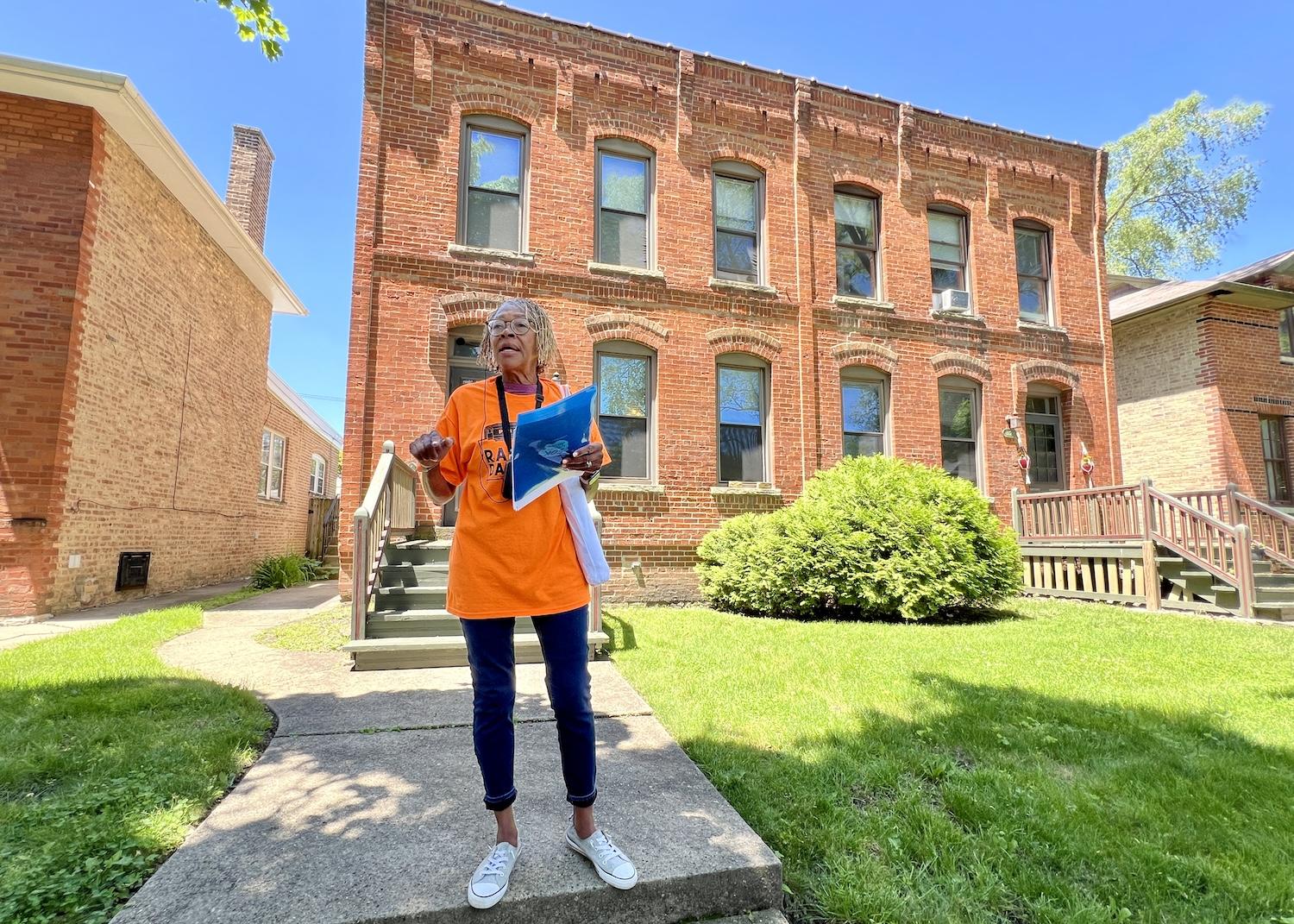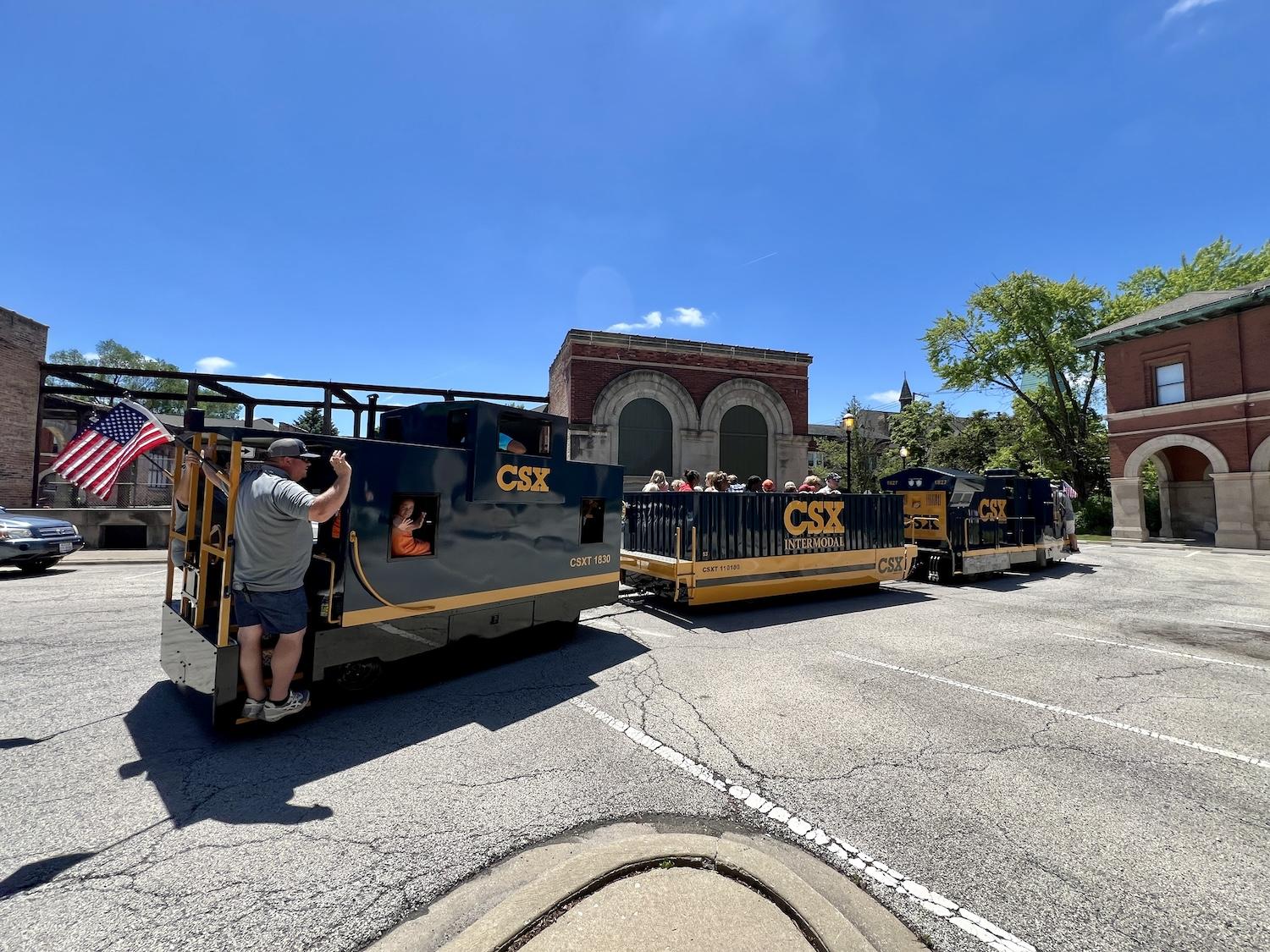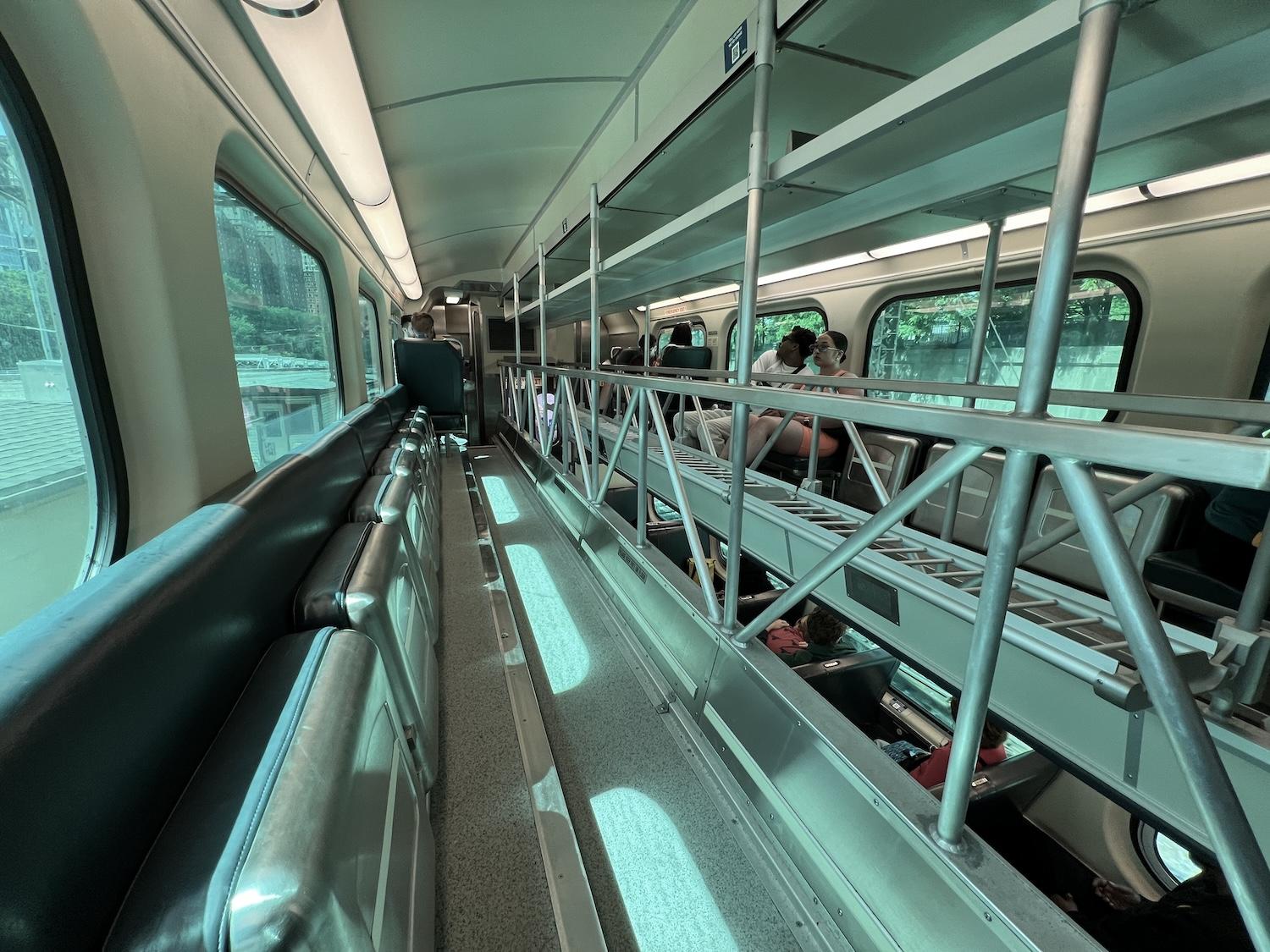At Metra Electric’s 111th St. Pullman station in Chicago, three privately owned railcars from a bygone era are parked on one side of the platform while plain jane commuter trains whiz by on the other side.
I’m taken with the retro shade of blue in the eight-seat observation lounge of the 1950 Blue Ridge Club. I hear how Hollywood Beach, a 1956 Art Deco solarium car, was one of just three of her kind ever made. The Dover Harbor, a sleeper-lounge originally built in 1923, has tiny bedrooms where the cushions on a chair fold up to expose a toilet and down to reveal a sink.
A guided tour through these historic beauties — all made right here by the Pullman Co. — sets the stage for a deep dive into the early days of luxury train travel in America.

Julie King, executive director of the American Association of Private Railroad Car Owners, shows off the 1950 Blue Ridge Club during Pullman Railroad Days/Jennifer Bain
I’ve come to Chicago in June to explore Pullman National Historical Park, a NPS unit that drew a modest 29,218 people last year and is apparently better known with international visitors than with Chicagoans.
It’s no ordinary day in the South Side urban park, though. It’s the third annual Pullman Railroad Days, a weekend-long celebration put on by the Historic Pullman Foundation, the park’s official Friends Group and philanthropic partner.
Saturday’s downpour has given way to Sunday sunshine and after a half-hour Uber ride from downtown, I arrive before things open to the public.

Pullman Railroad Days event chairman Joe Szabo stands by a mural that tells some of the Pullman story in Chicago's South Side/Jennifer Bain
“America’s stories live in Pullman,” event chairman Joe Szabo tells me as volunteers clad in orange shirts set up. “No matter who you are, you likely can find a part of your personal story in the stories of Pullman.”
The industrial revolution. Immigration. The Great Migration. Pullman porters. Civil rights. Labor history. The transformation of rail transportation as the railroads were changing America. Pullman tells interwoven stories.
Today is mainly a celebration of the railroad side of the story as Metra, Amtrak and the American Association of Private Railroad Car Owners team up to position the railcars for tours. But there are also neighborhood walking tours, replica train rides on CN’s Little Obie and CSX’s Mighty Chessie, and NPS rangers leading brickmaking, riveting and upholstery activities.
“Pullman is a living, breathing community today,” Szabo stresses. “The entire neighborhood and factory site has been designated a national park because of that instrumental role that it had in the transformation of America.”

Some signage at Pullman National Historical Park still refers to it as a national monument/Jennifer Bain
To be honest, parks like this that transcend linear boundaries and involve private/public partners/owners often confuse me on a first visit. I notice that the main sign at E. 111th St. and S. Cottage Grove Ave. says Pullman is a national monument and a state historic site.
President Barack Obama did indeed proclaim this place Pullman National Monument in 2015, making it the Windy City’s first NPS unit. But congress redesignated it a national historical site in 2022 so clearly new signage is in order.
Simply put, this park tells the story of America’s first planned model industrial community, the sleeping car magnate who created it and the workers (many of them formerly enslaved African Americans) who first lived here.
George M. Pullman founded the Pullman Palace Car Co. in 1867. Convinced that better living conditions would produce better workers, he bought 4,000 acres of vacant land south of Chicago and broke ground in 1800 on a manufacturing complex with worker homes and amenities. The “perfect town” included 1,300 housing units, manufacturing buildings, a church, theater, market, water tower and hotel.

The first thing George Pullman wanted people to see when they arrived in Pullman was this 700-foot-long Administration Clock Tower Building/Jennifer Bain
Pullman was a brand “equated with opulence and consistency and is still recognized worldwide,” explains a December 2023 joint general management plan for the national and state site.
Pullman was also the first completely planned major industrial model community in America. The development’s architecture (by Solon Spencer Beman), landscape architecture (by Nathan Franklin Barrett), and sanitation (by Benezette Williams) “were thoughtfully designed to provide good living conditions for workers, a significant departure from previous worker housing models and an improvement on what was generally available to workers in the free market in American cities at the time.”
But the factory town, the plan continues, “is a powerful example of the concept of corporate paternalism.” Employees — mainly European immigrants and migrants from the South and other parts of America — had to conform to the company’s expectations.

During Pullman Railroad Days, volunteer docent Denise Mercherson leads a walking tour of her beloved neighborhood/Jennifer Bain
There’s a lot to unpack as I explore the NPS visitor center and the foundation’s exhibit hall.
The park’s 206 acres in the historic Pullman neighborhood include privately owned properties, public infrastructure and state historic site. The NPS owns just one building, the Administration Clock Tower, and uses part of it as a visitor center.
Superintendent Teri Gage anticipates visitation “growing about five to 10 per cent a year until we get railcars on site, at which point we could easily see visitation triple or even quadruple.” That’s right — railcars (loaned from owners across America) are only here two days of the year on Railroad Days.

During Pullman Railroad Days, Julie King of the American Association of Private Railroad Car Owners shows off the Dover Harbor's bedroom with a unique toilet setup/Jennifer Bain
It surprises Gage how many locals either haven’t heard of Pullman or know about it but haven’t visited. “There’s a huge untapped audience. We’re a very young park and there are a lot of plans for new attractions. The Pullman National Historical Park that you see today is going to look very different 10 years from today.”
There's not a lot to eat nearby, but I find I Chicago-style Wagyu steak dogs at barbecue chef Dominique Leach’s Lexington Betty Smokehouse, and a turmeric chai from Pullman Club Coffee, which raises money for the Pullman House Project and plans to stage residential properties to interpret the life of workers and their families in the original town.

During Pullman Railroad Days, a tour group passes by Pullman Club Coffee, which raises money for the Pullman House Project/Jennifer Bain
When I learn that Pullman porter job helped created America’s black middle class, I’m reminded of Cane River Creole National Historical Park and the segregated train depot it will soon open as a visitor center/museum to tell the story of African Americans who fled Louisiana for better opportunities in the north during the Great Migration.
Between 1917 and 1937, the Pullman Co. was the nation’s largest employer of African Americans, and Pullman porters composed 44 per cent of its workforce. The National A. Phillip Randolph Pullman Porter Museum is closed for a major expansion, but one of the tour guides mentions that Michelle Obama’s great-grandfather was a Pullman porter.
“Without this place, Michelle wouldn’t be where she is today,” Barack Obama revealed during a 2015 speech in Chicago to announce Pullman and two other national parks.

Along S. Cottage Grove Ave., you'll find a mural celebrating the Pullman porters and Pullman National Historical Park/Jennifer Bain
The Pullman Co., of course, is no more. But it’s connected to two watershed moments in American labor history — the 1894 Pullman Strike and Boycott and the 1925 establishment of the Brotherhood of Sleeping Car Porters.
When an economic downturn led to flagging revenues, the company lowered wages but not rents. In 1894, Pullman factory workers walked off the job and American Railway Union members boycotted Pullman cars and disrupted rail traffic across the nation. This labor action was defeated, but Pullman was harshly criticized for his policies and refusal to enter into arbitration. Afterwards, the situation for Pullman residents remained dire.
Pullman died in 1897. By 1907, the company-owned housing and non-manufacturing buildings were sold and residents could buy their homes. The buildings then deteriorated, but when developers threatened to demolish much of the neighborhood in 1960, residents fought back and formed the Pullman Civic Organization. The district became a national historic landmark in 1972 and, after many twists and turns, a national historical park.

The ruins of what was once the Pullman Company's two-storey Market Hall in what's now Chicago's historic Pullman neighborhood/Jennifer Bain
“We had no idea this was down here.”
“We’ll be back.”
These are two comments that Szabo frequently hears from visitors as the Friends Group works to raise Pullman's profile. It runs walking tours, a speaker series and, every October, two days of house tours.

On Pullman Railroad Days, people take free replica train rides around the historic Pullman neighbourhood on CSX's Little Chessie/Jennifer Bain
On Railroad Days, as I get to know Pullman on four tours led by locals, I’m struck by everyone's passion for this historic South Side community, which I'm told is now safe, stable and racially balanced.
When it's time to head back downtown, I skip the Uber and return to the Metra station, bypassing the lineup for private railcar tours and hopping on a two-level commuter train.
Pullman expected workers to arrive by train and be astounded by the community he was building. From my train window, the 700-foot-long Administration Clock Tower Building — now sitting in a park-like setting instead of by an artificial lake — is the last thing I see and it's as ornate and as impressive now as it must have been then.

In Chicago, the two-level Metra train between downtown and the 111th St. Pullman station gets you to Pullman National Historical Park/Jennifer Bain



 Support Essential Coverage of Essential Places
Support Essential Coverage of Essential Places






